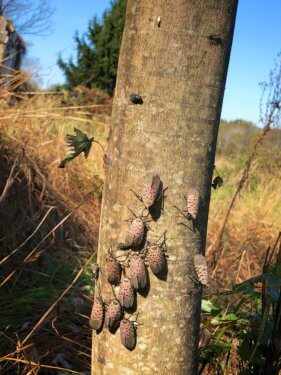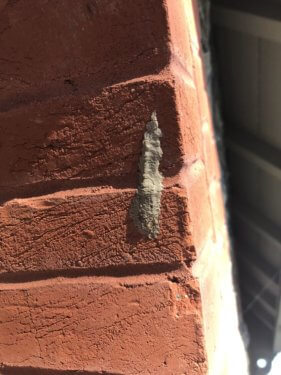Nature Conversations: Spotted Lanternfly
 The spotted lanternfly is a threat to many crops and trees. The Pennsylvania Department of Agriculture has asked us to “squash it, smash it” when we find them, but what does it look like in the spring, and what can we expect it to look like in a month?
The spotted lanternfly is a threat to many crops and trees. The Pennsylvania Department of Agriculture has asked us to “squash it, smash it” when we find them, but what does it look like in the spring, and what can we expect it to look like in a month?
Our expert on the spotted lanternfly is Sam Nestory, horticulturalist at Stoneleigh: a natural garden. Sam received a bachelor of science in ecology and a master of science in entomology from the University of Delaware.
Here are highlights from our conversation with Sam, originally presented on our Facebook page.
Spotted Lanternfly

Daniel Barringer
Sam: Hi all! Thanks for joining us to learn more about spotted lanternflies! Despite being quite beautiful, these invasive insects have serious impacts on our agriculture and gardens.
Have you found something that kills them without breaking the bank?
My favorite tool for killing them is actually a good, old-fashioned fly swatter (with a little help from my shoes). But the efficiency of this depends on how big your infestation is. Another great way to reduce their numbers is to scrape the egg masses during the winter and early spring.
What do you do if you find their eggs on a tree trunk? Is that the only place they lay them?
While they will often lay their eggs on the trunks of smooth-barked trees, that’s not the only place they lay them. They can also lay them on buildings, cars, walls, and other human-made structures. If you find an egg mass, gently scrape it into a container (like a jar or Tupperware) with rubbing alcohol. The alcohol is very important to kill the eggs.
Do you have a photo of an egg mass?

Spotted lanternfly egg mass.
Here’s a photo of an egg mass we found on the side of our office buildling at Stoneleigh. Egg masses are laid in the fall and don’t hatch until mid-April so you have plenty of time to search for and scrape them on your own property. When they’re first laid, they look like smears of mud or putty. The “putty” is a protective layer that can sometimes degrade over the winter, leaving small, seed-like eggs exposed.
Spotted lanternflys are really pretty! Too bad they’re devastating trees. Do they have any natural predators in our region?
Great question. Birds like wrens and flycatchers have been seen eating spotted lanternflies in their adult phase. They’re also eaten by generalist predator insects like mantids and spined soldier bugs. However, the best natural control that we’ve seen so far are actually two species of native fungus! Batkoa major and Beauveria bassiana are two species of entomopathogenic (insect-infecting) fungi and they can both kill spotted lanternfly in fairly large numbers.
Silly question: do we bring the fungus to the infected areas? If so, how? And when?
Not a silly question at all! There are multiple people currently working on turning these fungi into sprays that can be used against the spotted lanternflies. In the meantime, the best thing to do is leave any infected spotted lanternflies where they are. These fungi are very good at spreading their spores and the lanternflies are likely to spread them better than we could.
Hi, Sam. I want to look for these on my property (as I have only found one so far on a willow tree). Are there certain tree species they favor so I can look there? (We don’t have any trees of heaven, but our woods are full of other species.)
Great question. Spotted lanternflies eat lots of different species, but they prefer smooth-barked trees to lay their eggs on. If you have time to check them all, great! But if not (and we completely understand), focus on maples, birches, and cherries.
What future steps can be taken to prevent or lessen the impact of invasive critters?
Many of the first lines of defense have to start at the federal level – more port inspections of imported goods, implementation of non-plant-sourced packing materials, etc. On a local level, engaging in education and outreach is the best possible method of reducing their effects. Educate yourself, and then educate others! In addition to invasive insects, invasive plants are a huge threat to our ecosystem. Removing invasives from your garden, planting native, and educating your neighbors about the impacts of invasive species is a great way to get involved on a community level.
You can also get involved in invasive plant removal days at local gardens, parks, and preserves (like Natural Lands preserves)! It feels good to get involved, get dirty, and make a dent in the invasive plant populations in our favorite outdoor spaces.
